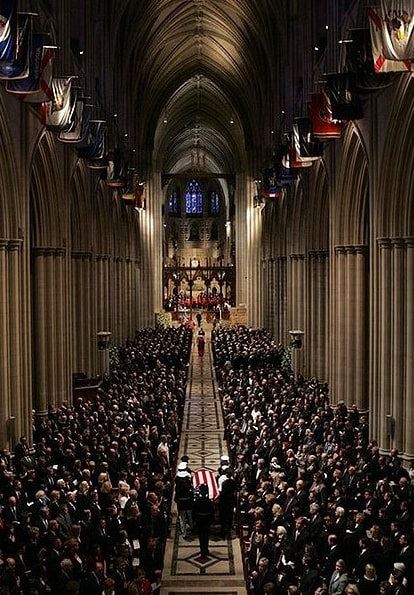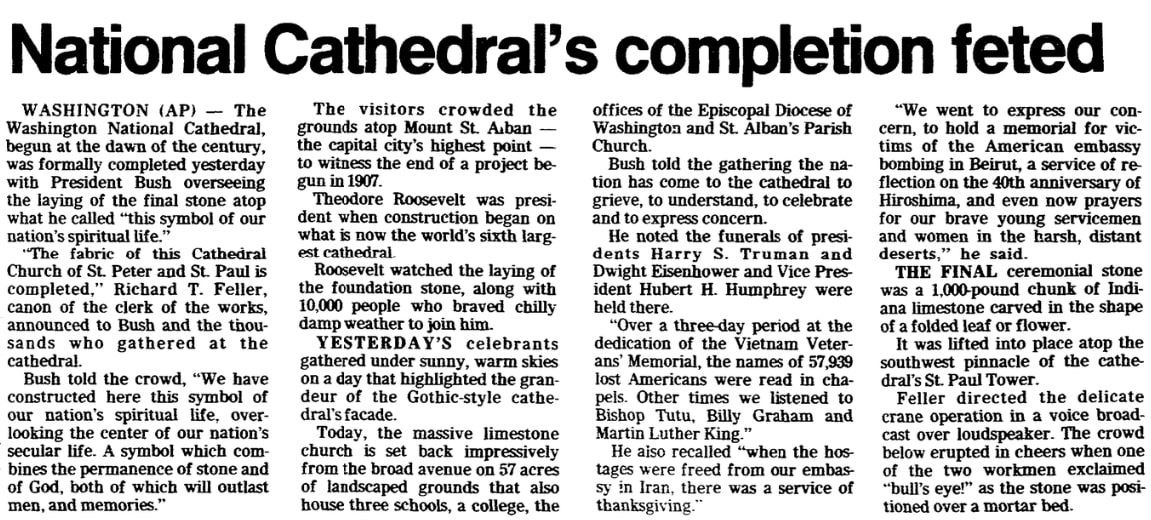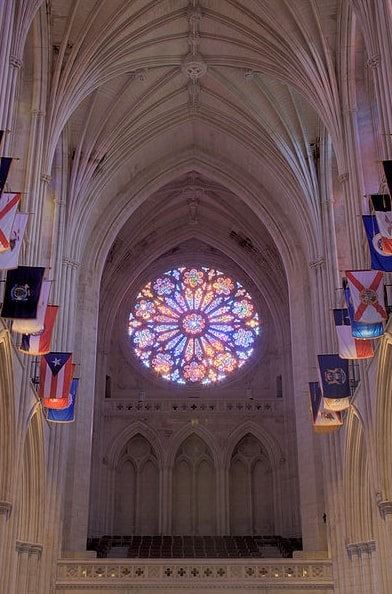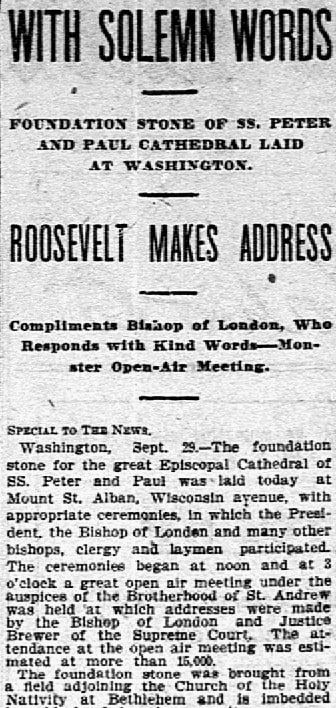In a similar ceremony exactly 83 years after the cornerstone was laid in 1907, a U.S. president – this time George H. W. Bush instead of Theodore Roosevelt – addressed a crowd celebrating the final stone being laid, as construction was completed on the Washington National Cathedral on 29 September 1990. A national cathedral was envisioned by Pierre L’Enfant, a French-born architect appointed in 1791 by President George Washington to design the nation’s new capital city on the north bank of the Potomac River. Nearly 200 years later, L’Enfant’s dream was a reality.

The Washington National Cathedral (the “Cathedral Church of Saint Peter and Saint Paul”) is a massive and magnificent building built primarily of Indiana limestone, the sixth largest cathedral in the world. It has over 200 stained glass windows, including one (the “Space Window”) that has an actual moon rock in its center. The Cathedral was constructed and is maintained entirely by private funds, operated by the Protestant Episcopal Cathedral Foundation. The Cathedral’s first chapel, Bethlehem Chapel, began services in 1912.
Even though no public funds are involved, Congress has designated the Cathedral the “National House of Prayer,” and it has played a large role in the nation’s spiritual and ceremonial life. Four state funerals for American presidents have been held there: Dwight Eisenhower in 1969; Ronald Reagan in 2004; Gerald Ford in 2007; and George H. W. Bush in 2018. One American president is buried at the Cathedral: Woodrow Wilson in 1924.

Special prayer services and memorials have been held at the Cathedral for such persons and events as: casualties of the Vietnam War; hostages in the American Embassy in Iran; the 40th anniversary of the bombing of Hiroshima; and victims of the 11 September 2001 attacks.

Here is a transcription of this article:
NATIONAL CATHEDRAL’S COMPLETION FETED
WASHINGTON (AP) – The Washington National Cathedral, begun at the dawn of the century, was formally completed yesterday with President Bush overseeing the laying of the final stone atop what he called “this symbol of our nation’s spiritual life.”
“The fabric of this Cathedral Church of St. Peter and St. Paul is completed,” Richard T. Feller, canon of the clerk of the works, announced to Bush and the thousands who gathered at the cathedral.
Bush told the crowd, “We have constructed here this symbol of our nation’s spiritual life, overlooking the center of our nation’s secular life. A symbol which combines the permanence of stone and of God, both of which will outlast men, and memories.”
The visitors crowded the grounds atop Mount St. Alban – the capital city’s highest point – to witness the end of a project begun in 1907.
Theodore Roosevelt was president when construction began on what is now the world’s sixth largest cathedral.
Roosevelt watched the laying of the foundation stone, along with 10,000 [correction: 20,000 – ed.] people who braved chilly damp weather to join him.
Yesterday’s celebrants gathered under sunny, warm skies on a day that highlighted the grandeur of the Gothic-style cathedral’s façade.
Today, the massive limestone church is set back impressively from the broad avenue on 57 acres of landscaped grounds that also house three schools, a college, the offices of the Episcopal Diocese of Washington and St. Alban’s Parish Church.
Bush told the gathering the nation has come to the cathedral to grieve, to understand, to celebrate and to express concern.
He noted the funerals of presidents Harry S. Truman and Dwight Eisenhower and Vice President Hubert H. Humphrey were held there.
“Over a three-day period at the dedication of the Vietnam Veterans’ Memorial, the names of 57,939 lost Americans were read in chapels. Other times we listened to Bishop Tutu, Billy Graham and Martin Luther King.”
He also recalled “when the hostages were freed from our embassy in Iran, there was a service of thanksgiving.”
“We went to express our concern, to hold a memorial for victims of the American embassy bombing in Beirut, a service of reflection on the 40th anniversary of Hiroshima, and even now prayers for our brave young servicemen and women in the harsh, distant deserts,” he said.
The final ceremonial stone was a 1,000-pound chunk of Indiana limestone carved in the shape of a folded leaf or flower.
It was lifted into place atop the southwest pinnacle of the cathedral’s St. Paul Tower.
Feller directed the delicate crane operation in a voice broadcast over loudspeaker. The crowd below erupted in cheers when one of the two workmen exclaimed “bull’s eye!” as the stone was positioned over a mortar bed.
1907 Ceremony
As mentioned above, the Washington National Cathedral completion ceremony in 1990 was similar to the ceremony when the cornerstone was laid in 1907. Even though Pierre L’Enfant had been appointed in 1791 by President George Washington, and a national cathedral was part of his plans for the nation’s new capital, Congress did not act on his cathedral idea for more than 100 years. Finally, a charter was granted to the Protestant Episcopal Cathedral Foundation of the District of Columbia on 6 January 1893, to build the grand edifice.

It then took an additional 14 years of planning and fundraising before construction could begin. Finally, on 29 September 1907, in a grand ceremony attended by over 20,000 people including President Theodore Roosevelt and the Bishop of London, the cornerstone of the Washington National Cathedral (the “Cathedral Church of Saint Peter and Saint Paul”) was laid with appropriate pomp and speeches. The cornerstone itself came from a field outside the Church of the Holy Nativity in Bethlehem. The trowel was the same one used in laying the cornerstone of the Capitol Building on 18 September 1793, and the Cathedral ceremony used George Washington’s gavel.
Expectations at the cornerstone ceremony were high, as indicated by this comment in the following 1907 newspaper article: “The cathedral promises to equal in point of architecture and outlay the most magnificent in the world.”

It took 83 years to complete, but the finished building lived up to those expectations. The Washington National Cathedral is a grand and inspiring building. The Cathedral, constructed entirely with private money, was placed on the National Register of Historic Places on 3 May 1974, before its official completion. It has been designated by Congress as the “National House of Prayer,” but its maintenance, like its construction, involves no public money.

Here is a transcription of this article:
WITH SOLEMN WORDS
Foundation Stone of SS. Peter and Paul Cathedral Laid at Washington.
Roosevelt Makes Address
Compliments Bishop of London, Who Responds with Kind Words – Monster Open-Air Meeting.
Special to The News.
Washington, Sept. 29. – The foundation stone for the great Episcopal Cathedral of SS. Peter and Paul was laid today at Mount St. Alban, Wisconsin avenue, with appropriate ceremonies, in which the President, the Bishop of London and many other bishops, clergy and laymen participated. The ceremonies began at noon and at 3 o’clock a great open air meeting under the auspices of the Brotherhood of St. Andrew was held at which addresses were made by the Bishop of London and Justice Brewer of the Supreme Court. The attendance at the open air meeting was estimated at more than 15,000.
The foundation stone was brought from a field adjoining the Church of the Holy Nativity at Bethlehem and is embedded in a block of American granite.
The great open air service brought to a close the international convention of the Brotherhood of St. Andrew, which has been in session here for the last week.
The cornerstone laying was under the guidance of the Episcopal Church in America. The cathedral promises to equal in point of architecture and outlay the most magnificent in the world.
Among the distinguished people in the assemblage, besides President Roosevelt and Bishop Ingram, were J. Pierpont Morgan, Chief Justice Fuller of the United States Supreme Court, Associate Justice Brewer, Secretary of the Navy Metcalf, Secretary of the Interior Garfield, Admiral Rixey, President Finley of the Southern Railway and President Needham of the George Washington University.
Among the prelates who took part in the exercises were Rt. Rev. A. E. Winnington-Ingram, lord bishop of London, who delivered the salutation; Rt. Rev. C. E. Woodcock, bishop of Kentucky; Rt. Rev. T. F. Gailor, bishop of Tennessee; and the bishops of Virginia and Maryland.
The religious services proper began with prayer by Rev. Dr. Randolph McKim of the Church of the Epiphany. Then Bishop Henry Y. Satterlee performed the ceremony of laying the foundation stone. The trowel was the one used in laying the foundation stone of the Capitol Building and the gavel was used by George Washington.
The ceremony of laying the foundation stone completed, Bishop Henry Y. Satterlee of Washington introduced President Roosevelt, who spoke as follows:
“Bishop Satterlee, and you, my friends and fellow-countrymen, and you, our guests:
“I have to say but one word of greeting to you today and to wish you Godspeed in the work begun this noon. The salutation is to be delivered by our guest, the Bishop of London, who has a right to speak to us because he has shown in his life that he treats high office as high office should alone be treated, either in Church or State, and above all, in a democracy such as ours – simply as a chance given to render service. If office is accepted by any man for its own sake and because of the honor it is felt to confer, he accepts it to his own harm and to the indefinite harm of those whom he ought to serve. Its sole value comes in the State, but above all its sole value comes in the Church, if it is seized by the man who holds it as giving the chance to do yet more useful work for the people whom he serves.
“More and more we have grown to realize that the worth of the professions of the men of any creed must largely be determined by the conduct of the men making these professions, that conduct is the touchstone by which we must test their character and their services. It would be to our shame and discredit if we failed to recognize that evil, if we wrapped ourselves in the mantel of a foolish optimism and failed to war with heart and strength against the evil. It would act equally to our discredit if we sank back in sullen pessimism and declined to strive for good because we feared the strength of evil.
“I thank you for giving me a chance to say this word of greeting today.”
Following the address of the President, the Bishop of London delivered the salutation.
Turning toward the President, the Bishop thanked him for his presence, “amidst all his multitudinous duties.” He also expressed his thanks for the “burning words of encouragement and inspiration of the President,” which, he said, would send him back across the seas inspired for his work.
The Bishop then referred to the Canterbury ambon, or pulpit, which he brought over as a gift to the cathedral.
“I come,” he said, “as the successor of St. Augustine’s champion, Miletus, to bring you from the old diocese of London, of which you one day were a part, a real message of love and Godspeed.”
Continuing, he said: “We stand for liberty. One of the most glorious sentences in the English history is that sentence in the great charter, ‘The Church of England shall be free.’ We stand for freedom of thought, freedom of study, for freedom of historical ministry, for an open Bible.”
Concluding, the Lord Bishop said he gave his salutation because “as the President says, we fight against wrong, against tyranny, against evils; we fight to relieve the poor and aid the oppressed on both sides of the Atlantic. Let the Church of England and the church of America fight in generous rivalry as to see which can do its best. And I say from my heart, Godspeed to your work today.”
Note: An online collection of newspapers, such as GenealogyBank’s Historical Newspaper Archives, is not only a great way to learn about the lives of your ancestors – the old newspaper articles also help you understand American history and the times your ancestors lived in, and the news they talked about and read in their local papers. The same is true of more recent news. Have you ever visited the Washington National Cathedral?
